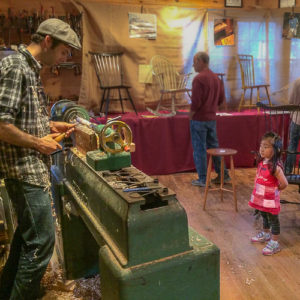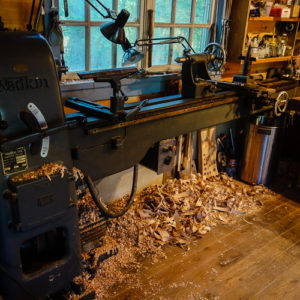I’ve been turning a lot lately. Five weeks ago I got an order for 40 chairs (28 loop backs and 12 Continuous Arm chairs) for a Michigan hunting camp’s dining hall. I’ve turned 250 legs, arm stumps and center stretchers on my 1800# pattermaker’s lathe. Seth has turned 80 side stretchers on his 200 pound Delta lathe, which works equally well, if not quite as solidly. I’ve whittled nearly 400 spindles and spent time writing on my book every day.
I’m having a ball. I’ve always wanted an order this large, to see just how fast I could work. I love turning the same part over and over again, watching myself get faster and – at the same time – more relaxed and less in a rush. I’ve recently gotten a few questions about what to look for in a lathe, so here’s some thoughts:
Things to think about:
Speed: I happily turn chair parts anywhere between 1000 and 2000 rpm. I sand parts and cut tenons with a turner’s gate at up to 3000 rpm, but these high speeds aren’t mandatory. Speed changes can be achieved with a step pulley, as my current lathes do. An electric speed dial or mechanical means of continuous speed adjustment is nice, since subtle changes in speed can help kill vibration.
Bed: Make sure that the bed of the lathe is made from two ways with a gap in between (some cheap lathes are made from one piece of pipe – not nearly as stable).
Ergonomics: You should be able to stand with your belly no more than a couple inches away from the bed of the lathe. Some lathes have protrusions that get in the way.
Weight: The piece of wood you are turning is a part of the machine while it is in the lathe. Chairmakers are constantly putting out-of-round pieces of wood in the lathe and no matter how perfectly balanced the lathe itself is, it will bounce around the room unless it has some weight. My 200# Delta works fine for most blanks (or I’ll knock some wood off with a hatchet to balance it), my 600# Powermatic 90 was pretty stable and my 1800# Pattermaker’s Lathe is smooth as silk no matter what goes in it.
Things you probably don’t need to think about:
Motor: A 1/2 hp motor is plenty for a chairmaker and I believe Dave Sawyer’s lathe that he used for decades had a 1/3 hp motor. In other words, there are very few lathes that would be under-powered for us.
Length Between Centers: Most chair parts are under 24″ and all of my parts are under 32″. Most lathes fit this.
Morse taper size: Is irrelevant for us. Just buy drive centers that fit your lathe.
Swing: A measure of the maximum diameter that can fit on the lathe, swing is unimportant for us chairmakers (unless you plan on turning table or stool tops, something I rarely do).
Old Lathes
I prefer vintage lathes. You can get a lot of weight for your money. Lathes are really simple machines – the main thing that goes wrong with them is the bearings, which are cheap and usually easy to replace. Some big old lathes have three-phase motors, which can be replaced with single-phase motors or run with a phase converter or variable frequency drive.
Old Woodworking Machinery: An amazing resource, OWWM is a forum for people interested in old machinery. I have bought several machines from the classifieds on this site and their sister site Vintagemachinery.org, which also has a huge library of free owner’s manuals for machines dating back over 100 years.
New lathes
I’m no expert on modern lathes, but here are my thoughts. A ‘midi’ lathe with a bed extension will work fine for chairmakers, if you plan to do some work with the drawknife and ax before mounting the blanks in the lathe. Brand isn’t important. Many planers are made in the same factory, regardless of brand – I bet lathes are similar. Of course if you spring for a Powermatic or Oneway, you’ll get a machine that will last longer, but Grizzley, Jet, Laguna, Woodtek etc. are all similar in quality, as far as I can tell.
After you get it home:
Height: The lathe centers should be an inch or two above your elbow. To achieve this height, he average person will need to to put most lathes onto wooden blocks several inches thick; my lathe is blocked up about six inches.



Hello all you fellow woodworkers…
My name is Russ and I’m creating a woodworking shop in my garage. Just bought a brand new house. I’ve been designing and making furniture since 8th grade (13yo). I’m retired now with 35 professional years experience designing furniture. I once worked for The Lane Co. The very best furniture manufacturer in the USA. Period.
Anyway, I’m looking for a good, solid lathe.
RS
Hi There Elia! I noticed three things in the first picture, (1) is your tool rest a block of wood? I’m often frustrated with having to move my rest up and down the billet/work. A long block may be my solution but it does prevent me from adjusting up and down. Sometimes I’m using an EasyTurner, (2) You have several calipers on the bed. I’m always wasting time resetting my measuring instruments. Do you have a different caliper for each element/bulb/etc?, and (3) most importantly, the little girl enamored with you! Very cute! What was the story there?! Thanks!
1: Yes, I make my own wooden tool rests. More info here: https://youtu.be/kCCDt6ThHds
2: Yes, one caliper per measurement (usually no more than five per part).
3: I was on the studio tour here and she came in with her parents. Kids love turning!